Understanding Twitter Part 1: What is Twitter?
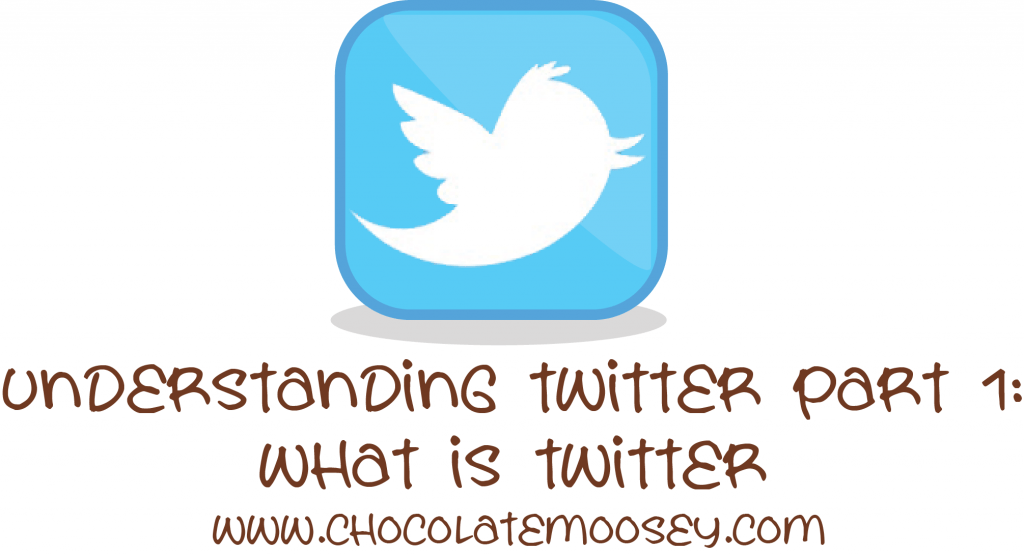
Today I am bringing you another technology post. Seems like you guys really like those based on feedback. Joan of Chocolate, Chocolate, and More asked if I would do a mini-series on explaining Twitter. She already has posts explaining Facebook and Pinterest but is a Twitter newbie herself.
Since there is so much going on with Twitter, I am dividing my guide into several parts. Part one is explaining Twitter and common terminology. You need to know how it works before you can use it to promote your blog. As you will see, it is rather lengthy, so I will not be covering much else. Stay tuned for part two (and possibly more) where I will talk about using Twitter to promote your blog and Twitter etiquette.
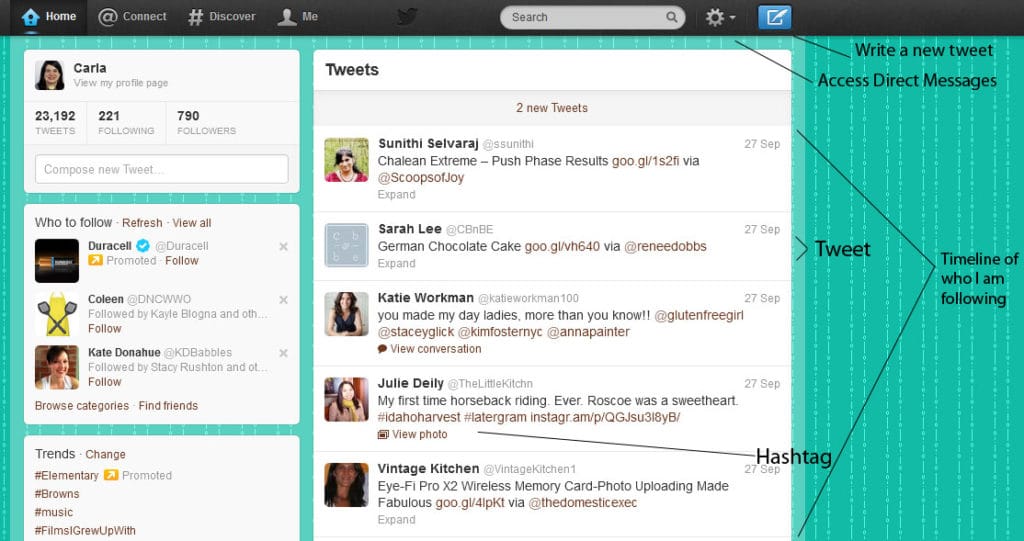
What is Twitter? Twitter is a social media platform that lets you post statuses 140 characters or less. People can follow along and reply. Of course with every social media system, there is terminology you need to know. Here are the definitions up front. Afterwards, I will explain them in detail.
- Tweets: status updates that are 140 characters or less
- Username: your account name with @ in front. Also referred to as your Twitter handle
- Followers: The people that read your tweets
- Following: The people whose tweets you are reading
- Timeline: Home page where your read tweets from those you are following
- Retweet (RT): Sharing someone else’s tweet
- Modified Tweet (MT): Sharing someone else’s tweet that you edited
- Direct Message (DM): a private message sent on Twitter. In order to send/reply to a message, that person must be following you
- Hashtag: a keyword or topic marked with #
- List: a way to organize people you are following into groups
- Public account: anybody can read your tweets, regardless if they are following you or not
- Private account: only your approved followers can read your tweets
To see the entire Twitter glossary, click here. I’m sorry but I simply cannot cover everything.
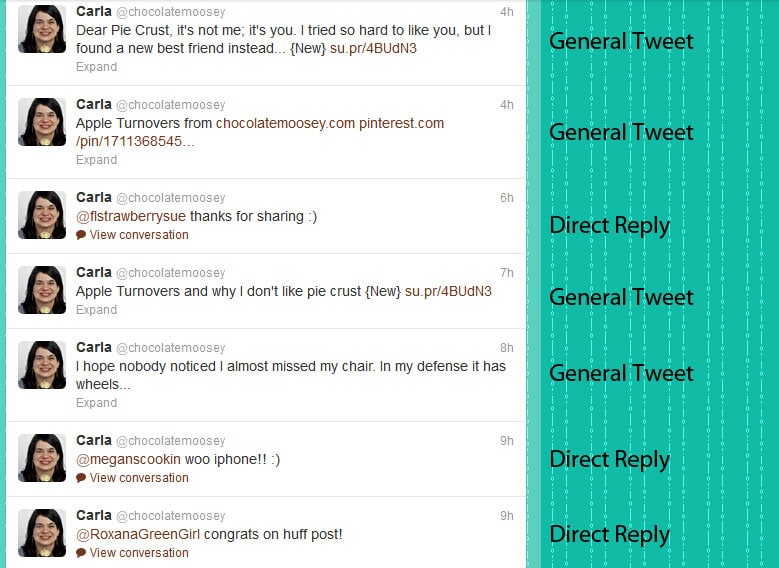
Tweets, Followers, Following, and Timeline: When you type a sentence or two into a new status, that is called a tweet. If you visit someone’s profile, you’ll see two types of tweets – ones that are general statements for everyone to see and ones that are a direct tweet to another user. Direct tweets (or a reply) will start out with a Twitter username (if you want to tweet me directly, you would put “@chocolatemoosey hey how was your weekend?”) Your followers don’t typically see your direct tweets in their timeline unless they are following both you and the person you are tweeting. However, if they visit your profile, they can see these tweets in addition to your general ones.
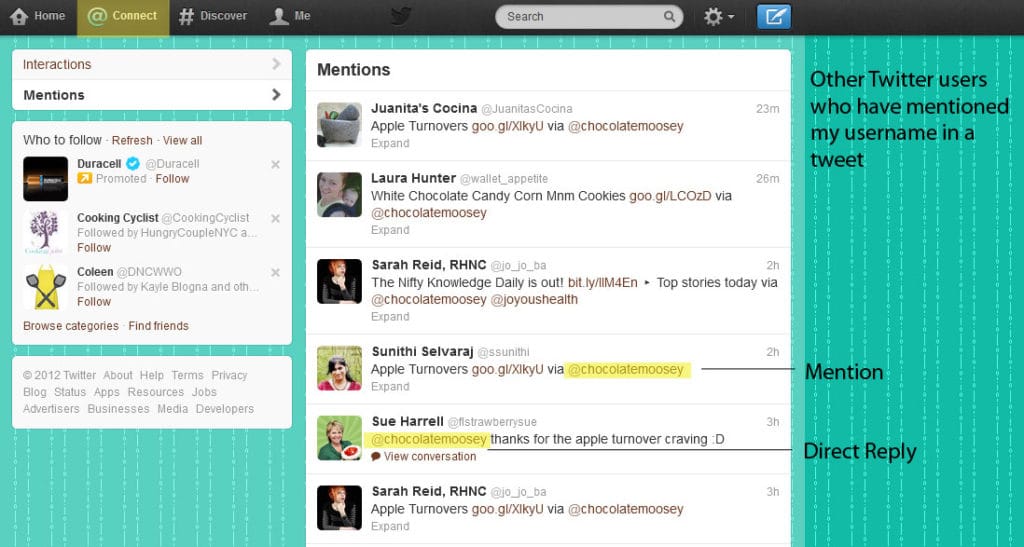
When a tweet contains your username, it is referred to as a mention. Mentions can be a direct reply or can be a general message (such as someone sharing your link). The difference between your mention and interaction page is interaction lists all ways people have interacted with you, such as new followers, favoriting a tweet, or retweets. Mentions are simply tweets that mention your username.
The biggest difference between Twitter and Facebook is by nature, Twitter is a one-way street. Unlike Facebook friends, followers and following are not reciprocated. Just because someone is following you does not automatically mean that you are following that person. It is good manners to follow someone back, but if you don’t want to see their tweets in your timeline, you don’t have to. If a shoe company follows me, I’m not going to follow them and read about shoes I’m not going to buy. I have 1000+ new tweets to read daily. I need to focus on the followers I care about and not worry about those who may not fit with my interests. If your tweets don’t add benefit to my timeline (and everyone’s idea of benefit is different), then I’m not going to follow you. It’s nothing personal.
The most efficient way to make Twitter a benefit of your time is by making it a two-way street. Yes you want to promote yourself, but you also want to interact with others. Twitter is about having conversations. Imagine texting someone without actually giving out your phone number or worrying about international charges. That’s how I think of Twitter. Now imagine texting someone who never responds. Boring, isn’t it? Twitter isn’t fun unless there is interaction. Don’t wait for a reply though – be proactive about it! Instead of waiting for someone to tweet you, find a tweet and reply to it. If someone says “what’s for dinner?” reply with “I’m having this for dinner.” That person may say “Oh I love that! Do you have a recipe?” And you can respond “Yes I do! I throw all of this into a pot and cook.” That little bit of “bonding time” makes your Twitter experience more personal.
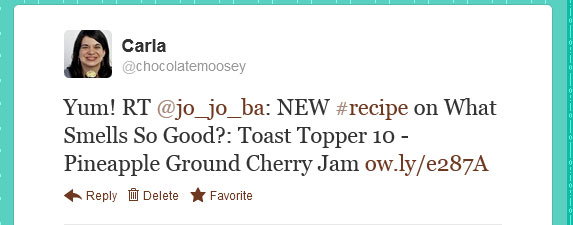
Retweets (RT) and Modified Tweets (MT): Sometimes, someone you are a following writes a tweet you want to share with your followers without having to rewrite it. You can retweet it. For example, if person A has a new post for jam I want my followers to know about, I retweet it. This tweet will then be posted on my profile, saying that the tweet is from so-and-so and not written by me. There are two types of retweets – you can either retweet it as is or you can retweet with a comment. I try to add a comment, like “check these out” or “yum! must make.” It makes it more personable. Of course, you have the 140 character limit, so I can’t always add a comment. That’s where you may modify the original tweet in order to fit the limit, sometimes prefaced with MT, or modified tweet. Personally, I just leave RT and not put MT, but I’m starting to see MT more and more.
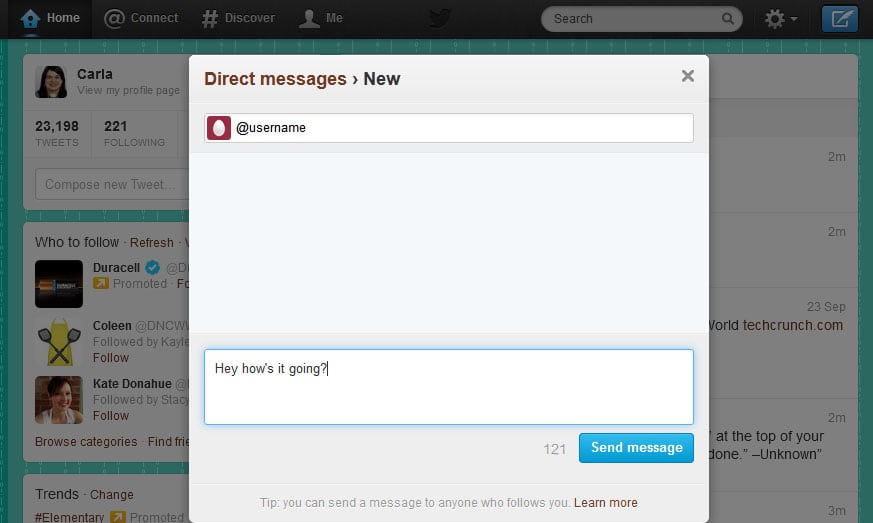
Direct Messages (DM): If you want to send a tweet to someone privately, you can send a direct message. You can only message those who are following you. This is also another one-way tool. If you are following someone, say a company, that person can DM you. However, if that user is not following you back, you cannot reply, even if you got the message in the first place.
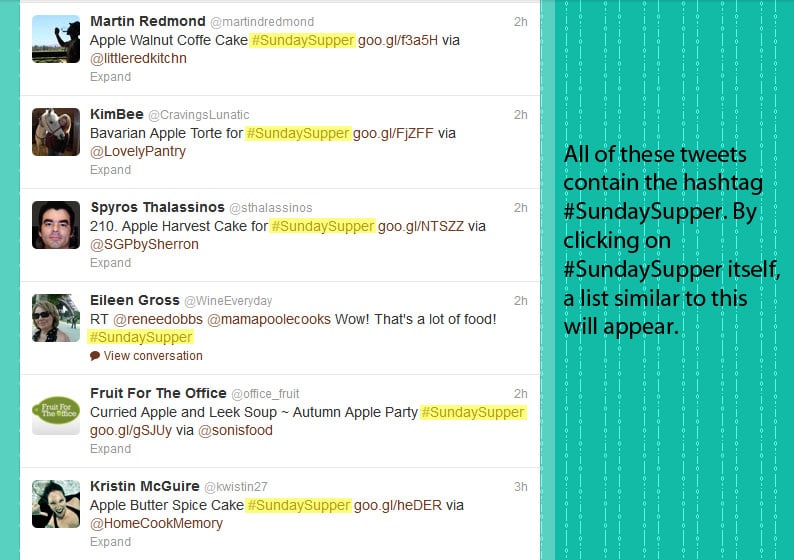
Hashtags: One thing you’ll notice on Twitter is # followed by a word (#SundaySupper, #photography, #baking). These are called hashtags, which are keywords or phrases that categorizes tweets. When you click on the hashtag word, you will see a list of tweets containing the same keyword. Hashtags are also used in tweet chats. A tweet chat is when a group of people get together on Twitter at a certain time and talk about a certain topic. For example, every Sunday night at 7 pm, a group of us gather to talk about #SundaySupper. If you go to Tweet Chat and typed in the designated hashtag (in this case #SundaySupper), you can follow along with the tweets. Usually the chat host will ask a question and everyone tweets back with an answer. It’s a great way to tweet with those who share the same interest.
When a hashtag becomes very popular, it will show up in the trending list. This means a whole bunch of users at that moment are using that hashtag.
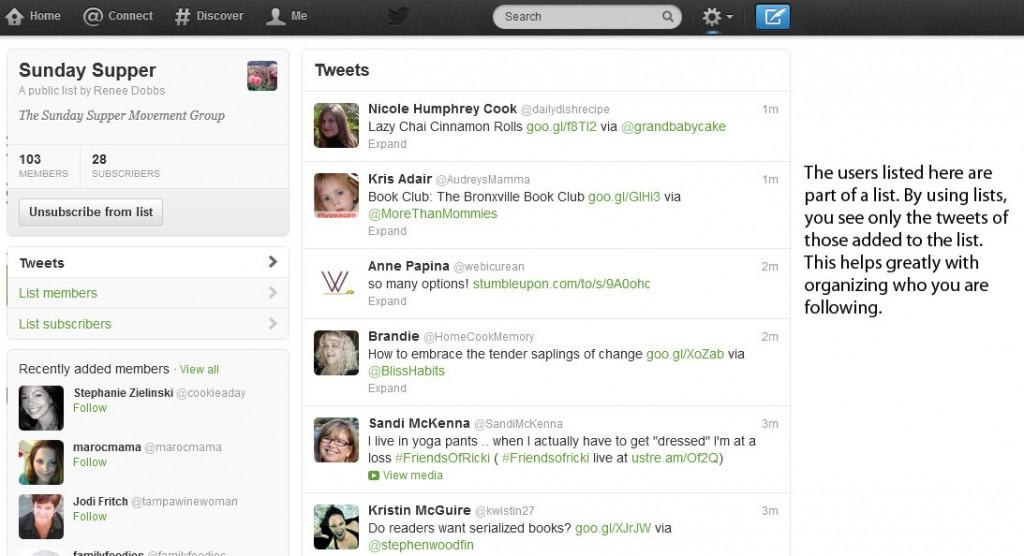
Lists: The more people you follow, the longer your timeline becomes. How do you keep track of everyone? Twitter has a feature called lists, where as the name implies, you can categorize your following into lists. If you follow people who are into cooking, photography, and gardening, you may have three lists. If you just want photography tweets, you can select your photography list and see only the relevant people. I personally don’t use lists, but I know others who swear by them. You can also follow someone else’s list. I’m in the group #SundaySupper, and my friend Renee created a #SundaySupper list. Instead of me creating my own list, I can just go to her profile and follow hers. No sense in remaking the same list.

Public and Private Accounts: Most accounts are accessible to the public, meaning you do not have to be following someone to read their tweets. You can visit mine right now (http://twitter.com/chocolatemoosey) and read what I’m saying without logging into Twitter once. On one hand, anybody can search for me and hopefully be intrigued enough to follow me; however, on the other hand, anybody can search for me, including potential employers and current coworkers. You have to learn how to censor yourself, which I’m learning to do more each day (when my cat went missing for 9 days, I had a few not-so-upbeat tweets). I read somewhere that if you don’t want it advertised on a billboard, don’t tweet it. People want happiness and positive thinking. Negativity drives people away. I’m not perfect following this rule, but I *am* getting better.
If the thought of having your tweets read by the public concerns you, you can set your account to private. This means those who want to follow you have to be approved by you. Keep in mind if you are promoting a company or blog, it is not a good idea to have a private account. I don’t bother following private accounts unless I know who that person is. Also, all private account tweets cannot be retweeted, so if you are promoting something, nobody can retweet it.
That is it for part 1. I wanted to explain what Twitter is and the terminology used. Come back next Saturday for part two where I will focus more on how to use Twitter to promote your blog and Twitter etiquette.
This post may contain affiliate links. As an Amazon Associate and member of other affiliate programs, I earn from qualifying purchase.


You’re so fabulous at these type of posts! Even I learned something and I’m a tweeting fiend!
Thank you! I have a twitter account and that’s about it! I so need this!
This is awesome! I know some people that need this!
Carla, you should have been a teacher. I’m not very fluent on Twitter and although, I’ve managed to figure most of this out over the past year, I’ve still learned a couple of things today. Looking forward to the subsequent posts!
I thought I was pretty good for a novice but I’m glad to know about MT. Would you add the link to this and your other photo tutorials as well as Joan’s tutorials to the appropriate docs on FBN? I think these are great!
This is WONDERFUL!!!! I may even use this page as a training tool in my workplace for those on the team that need to better understand social media. WONDERFULLY WRITTEN!
Carla, this is awesome, thank you! So much to take in, I’ve pinned so I can refer back to this and I’m made a goal to tweet at least 5 times a day and see what happens! Looking forward to more info next week!
That was so helpful. I have been wondering about twitter….the whats, how tos, etc.
Thanks for the great explanation. I just need to convince myself that I NEED to be there tweeting as well as all the other social media platforms I cover!
Facebook is my go to medium of choice!
Well done on this tutorial, Carla! Sharing now!
You seriously need to look into a career in training or writing training documents. You have a talent for putting things into words in a way that is easily understandable.
Oh, and thanks for mentioning me and my #SundaySupper list. It is a wonderful one for people to subscribe to (filled with great bloggers who value a good meal around the family table).
Thank you for sharing this. I’ve been FBing since 2007, so when I started my blog this year, it was easy to create a FB page for it. Since I’ve never joined Twitter, I had been too intimidated to set up an account for my blog although I know I should. You’ve given me the confidence to do it!
Thank you and Joan @Chocolate, chocolate, and more chocolate for doing this! I have trouble keeping up with all the different ways (and reasons) to use social media. This has helped me understand Twitter so much better!
Great article with lots of tips … Thx :-)
Thanks for the tips! I am a twitter newbie and this helps a lot. I will be pinning for future reference & looking forward to part2. Have a wonderful week :)
Great info. I tweet my posts and instagram pictures, but it’s hard to keep up with Twitter sometimes. Looking forward to next weeks post.
Please stop by my first Co-hosted Linky party and share a few posts.
http://pintsizedbaker.blogspot.com/2012/09/new-design-and-first-linky-party.html
Thanks :)
Thank you so much for doing this. I got a twitter account a few months ago and just haven’t used it because I have no idea now! Not any more…new resolution…use Twitter to best of my ability – with your help! Have a great day
Rebecca
Heronscrafts.blogspot.com
I just wing it on Twitter (and it shows!)…thanks for the wonderful explanation! I need to print this out!!!
Thanks for that I enjoyed it. Can’t wait for part 2. Cheers, Tara
Pingback: Cherry Cupcakes, BDTK/Chocolate Moosey and Foodie Penpal | Cravings of a Lunatic
Pingback: Food Bloggers: Everything You Need to Know | Recipe Girl